
The Seminole Wars were a series of three military conflicts between the United States and the Seminoles that took place in Florida between about 1816 and 1858. The Seminoles are a Native American nation which coalesced in northern Florida during the early 1700s, when the territory was still a Spanish colonial possession. Tensions grew between the Seminoles and settlers in the newly independent United States in the early 1800s, mainly because enslaved people regularly fled from Georgia into Spanish Florida, prompting slaveowners to conduct slave raids across the border. A series of cross-border skirmishes escalated into the First Seminole War in 1817, when General Andrew Jackson led an incursion into the territory over Spanish objections. Jackson's forces destroyed several Seminole and Black Seminole towns and briefly occupied Pensacola before withdrawing in 1818. The U.S. and Spain soon negotiated the transfer of the territory with the Adams-Onis Treaty of 1819.

Joseph Eggleston Johnston was an American career army officer, serving with distinction in the United States Army during the Mexican–American War (1846–1848) and the Seminole Wars. After Virginia declared secession from the United States, he entered the Confederate States Army as one of its most senior general officers. From 1888 to 1889 he was a vice president, from 1889 to 1890 president, of the Aztec Club of 1847.

The Peninsula campaign of the American Civil War was a major Union operation launched in southeastern Virginia from March to July 1862, the first large-scale offensive in the Eastern Theater. The operation, commanded by Major General George B. McClellan, was an amphibious turning movement against the Confederate States Army in Northern Virginia, intended to capture the Confederate capital of Richmond. McClellan was initially successful against the equally cautious General Joseph E. Johnston, but the emergence of the more aggressive General Robert E. Lee turned the subsequent Seven Days Battles into a humiliating Union defeat.

The Second Seminole War, also known as the Florida War, was a conflict from 1835 to 1842 in Florida between the United States and groups of people collectively known as Seminoles, consisting of Native Americans and Black Indians. It was part of a series of conflicts called the Seminole Wars. The Second Seminole War, often referred to as the Seminole War, is regarded as "the longest and most costly of the Indian conflicts of the United States". After the Treaty of Payne's Landing in 1832 that called for the Seminole's removal from Florida, tensions rose until fierce hostilities occurred in the Dade battle in 1835. This conflict started the war. The Seminoles and the U.S. forces engaged in mostly small engagements for more than six years. By 1842, only a few hundred native peoples remained in Florida. Although no peace treaty was ever signed, the war was declared over on August 14, 1842.
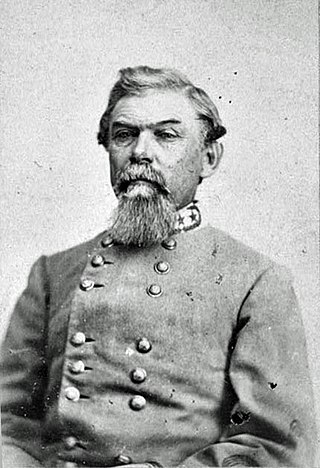
William Joseph Hardee was a career U.S. Army and Confederate States Army officer. For the U.S. Army, he served in the Second Seminole War and in the Mexican–American War, where he was captured and exchanged. In the American Civil War, he sided with the South and became a general. Hardee served in the Western Theater and quarreled sharply with two of his commanding officers, Braxton Bragg and John Bell Hood. He served in the Atlanta Campaign of 1864 and the Carolinas Campaign of 1865, where he surrendered with General Joseph E. Johnston to William Tecumseh Sherman in April. Hardee's writings about military tactics were widely used on both sides in the conflict.

John Clifford Pemberton was a career United States Army officer who fought in the Seminole Wars and with distinction during the Mexican–American War. He resigned his commission to serve as a Confederate lieutenant-general during the American Civil War. He led the Army of Mississippi from December 1862 to July 1863 and was the commanding officer during the Confederate surrender at the Siege of Vicksburg.
The Battle of Lake Okeechobee was one of the major battles of the Second Seminole War. It was fought between 800 troops of the 1st, 4th, and 6th Infantry Regiments and 132 Missouri Volunteers, and between 380 and 480 Seminoles led by Billy Bowlegs, Abiaca, and Halpatter Tustenuggee (Alligator) on 25 December 1837. Halpatter Tustenuggee had played a major role in the Dade Battle two years earlier. The Seminole warriors were resisting forced relocation to a reservation in Oklahoma. Though both the Seminoles and Taylor's troops emerged from the battle claiming victory, Taylor was promoted to the rank of brigadier general as a result, and his nickname of "Old Rough and Ready" came mostly due to this battle.

David Emanuel Twiggs, born in Georgia, was a career army officer, serving during the War of 1812, the Black Hawk War, and Mexican–American War.

Fort Dallas was a military base during the Seminole Wars on the banks of the Miami River in what is now Downtown Miami, Florida, United States.
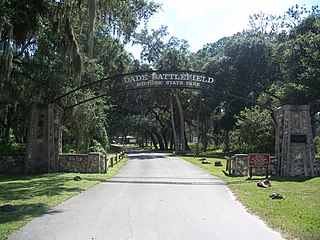
Dade Battlefield Historic State Park is a state park located on County Road 603 between Interstate 75 and U.S. Route 301 in Sumter County, Florida. The 80-acre (32 ha) park includes 40 acres (160,000 m2) of pine flatwoods and a live oak hammock. Also called the Dade Massacre site, it preserves the Second Seminole War battlefield where tribal Seminole warriors fought soldiers under the command of Major Francis L. Dade on December 28, 1835. Each year, on the weekend after Christmas, the Dade Battlefield Society sponsors a reenactment of the battle that started the Second Seminole War.
Ar-pi-uck-i, also known as Abiaka or Sam Jones, was a powerful spiritual alektca and war chief of the Miccosukee, a Seminole–Muscogee Creek tribe of the Southeast United States. Ar-pi-uck-i successfully defied the U.S. government and refused to remove to the Indian Territory west of the Mississippi and his influential leadership in the Second Seminole War (1835–1842) resulted in the permanent Native American presence in Florida.

The Dade battle was an 1835 military defeat for the United States Army. The U.S. was attempting to force the Seminoles to move away from their land in Florida and relocate to Indian Territory. Amidst a war between the Government of the United States and the Seminole two U.S. Army companies numbering 103 men under the command of Major Francis L. Dade were ambushed by approximately 180 Seminole warriors as they marched from Fort Brooke on Tampa Bay to reinforce Fort King in Ocala. Only three U.S. soldiers survived the attack, and one died of his wounds the following day.
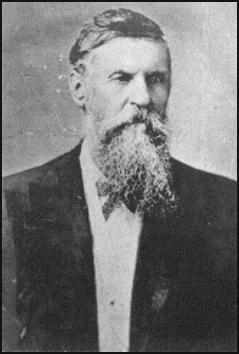
William Steele was a career military officer and businessman who served as the 16th adjutant general of Texas from 1874 until 1879. He previously served as a senior officer of the Confederate States Army who commanded cavalry in the Trans-Mississippi Theater of the American Civil War.

Seminole is a 1953 American Western film directed by Budd Boetticher and starring Rock Hudson, Barbara Hale, Anthony Quinn and Richard Carlson. Much of the film was shot in the Everglades National Park, Florida. The film depicts the Second Seminole War (1835-1842).
Riverbend Park is a 680-acre (280 ha) park in the Jupiter Farms section of Jupiter, in Palm Beach County, Florida. The area includes the Riverbend Regional Park Historic District with Indian middens and a preserved battlefield from the Seminole War at the Loxahatchee River Battlefield Park adjacent to Riverbend. The park includes 10 miles of hiking/biking trails, 7 miles of equestrian trails and 5 miles of canoeing/kayaking trails and includes a section of the Loxahatchee River, a National Wild and Scenic River. A Florida cracker farmstead is displayed, as well as a Seminole-style chickee for picnics.
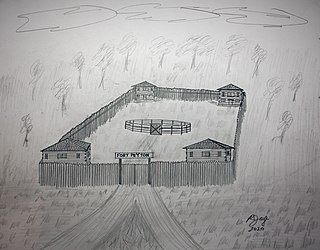
Fort Peyton was a stockaded fort built in August 1837 by the United States Army, one of a chain of military outposts created during the Second Seminole War for the protection of the St. Augustine area in Florida Territory. Established by Maj. Gen. Thomas Jesup, it was garrisoned by regular army troops.
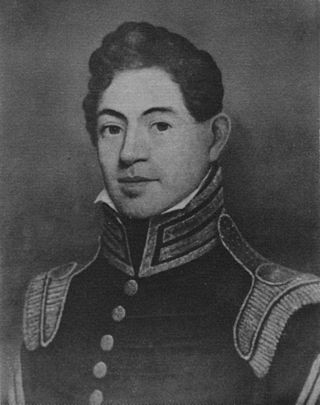
Benjamin Kendrick Pierce was a career officer in the United States Army. He was a son of New Hampshire Governor Benjamin Pierce and brother of President Franklin Pierce. Benjamin K. Pierce was a veteran of the War of 1812, the Second Seminole War, and the Mexican–American War, and rose to the rank of lieutenant colonel in the Army and colonel in the Florida Militia.
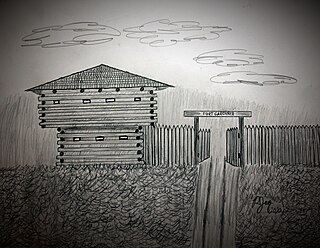
Fort Gardiner was a stockaded fortification with two blockhouses that was built in 1837 by the United States Army. It was one of the military outposts created during the Second Seminole War to assist Colonel Zachary Taylor's troops to capture Seminole Indians and their allies in the central part of the Florida Territory that were resisting forced removal to federal territory west of the Mississippi River per the Indian Removal Act.

William Lauderdale was an American planter-soldier from a prominent Virginia family. He served in both the War of 1812 and the Seminole Wars.
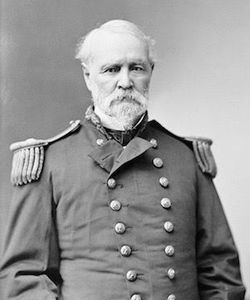
Levin Mynn Powell was a rear admiral of the United States Navy. He was known for his service in the Second Seminole War and developing riverine warfare techniques to fight the Seminole. He also served with the Union Navy in the American Civil War.
















